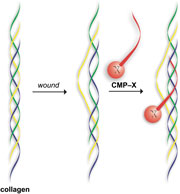
|
Representation of a collagen mimetic peptide (CMP) annealing to damaged collagen to anchor a molecule (X) in a wound bed
|
Posted on 04/12/2012 8:07:54 PM PDT by neverdem
A collagen-binding peptide with applications in wound healing has been developed by scientists in the US. The peptide is able to invade the strands of collagen, forming a strong and stable non-covalent bond at room temperature. Pendant drug molecules could be attached to the peptide and anchored at the wound site to aid wound healing.

|
Representation of a collagen mimetic peptide (CMP) annealing to damaged collagen to anchor a molecule (X) in a wound bed
|
Even though these peptides bind very strongly to collagen, they do not bind to each other. They exist as single strands looking for a partner. In a wound, single strands find the most partners in the areas where the collagen is most exposed and frayed. Although the peptides are simply following the laws of thermodynamics, elegantly, this is where they are needed most.
Raines' team is starting to apply their work to some practical problems in biomedicine, such as attaching dyes to the peptide for wound assessment. 'I really like this project because it extends truly from a quantum mechanical understanding of a complex biological molecule to a practical application that we think could help lots of people day to day,' says Raines.
'The use of annealing collagen mimetic peptides represents a significant advance over prior methods of collagen modification, which typically relied on covalent modification,' says Gregg Fields, an expert in synthetic protein design and construction at the Torrey Pines Institute for Molecular Studies, US. 'This creative approach is sufficiently flexible to allow for selective therapeutic intervention, which could greatly facilitate the healing process in a variety of difficult to treat wounds.'
In the future, Raines' team plans to use the collagen-binding peptide to anchor drug molecules to the frayed collagen at wound sites. The peptide may be useful for the treatment of painful wounds, such as burns, because it can decrease the number of repeat applications required.
Interesting? Spread the word using the 'tools' menu on the left.
S Chattopadhyay et al, Org. Biomol. Chem., 2012, DOI: 10.1039/c2ob25190f
Oh! Awesome Sh*t designed by the same stupid a** h#les who invented lyme, autism, asthma,ms,fibro etc.
WOW! Great nooze!
What are these ill educated buttholes gonna come up with next?
We have more poison vaccines (Thanks Obozo!) than we can shake a stick at!!!
Drove by a Walgreens next to Hospital today... electric sign welcomed all to come get “Shingles Vaccine”? Are people freakin’ crazy or what?
There are very few “wonder” drugs!
The more crap you allow them to inject into your body... the sicker you will become!
God had a “plan”... this was not it.
Population Control......
Anyone??? Ferris? Anyone?
Sorry for the rant! This stuff DOES make me wonder about the ability of my fellow human beings to actually think for themselves
Is logic a lost art?
Rapidly spotting major earthquakes using GPS
Nanomachines could benefit from superlubricity
Antibiotic Resistant Bacteria Found In Four Million-Year-Old Cave
FReepmail me if you want on or off my health and science ping list.
Shingles is very painful and, if it attacks in the eye, can cause decrease of vision or even blindness. A shingles vaccine is a good thing.
These investigations into the mechanics of healing will speed healing and reduce scarring. Scarring is not just a cosmetic problem, but can decrease function if it forms around an active muscle and ongoing pain if it forms around a nerve.
I think your rant is misplaced. Perhaps one day you or someone you care about will require one of these interventions. By then, you and your physicians will likely take them for granted. These are simply, IMO, awesome investigations/developments that will make life better for most of us.
Disclaimer: Opinions posted on Free Republic are those of the individual posters and do not necessarily represent the opinion of Free Republic or its management. All materials posted herein are protected by copyright law and the exemption for fair use of copyrighted works.